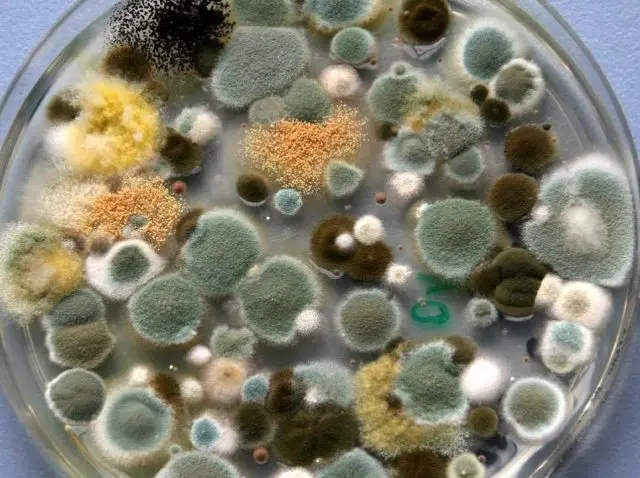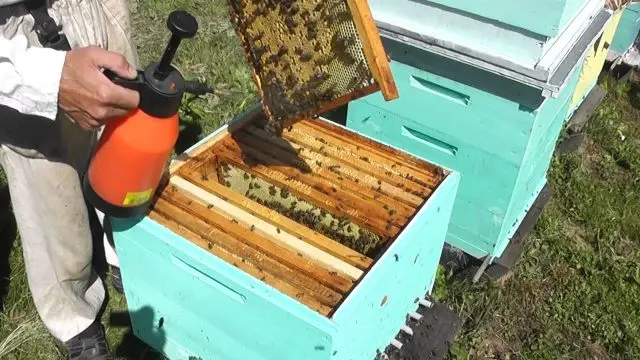Contents
Bee aspergillosis (stone brood) is a fungal disease of bee larvae of all ages and also adult bees. Although the causative agent of this infection is very common in nature, the disease of bees is rarely found in beekeeping. Its appearance is usually associated with a period of active honey collection or damp spring weather. But the consequences of infection can be severe. To prevent this from happening, you need to take measures to combat the fungus as soon as possible.
What is dangerous disease
Aspergillosis in bees can spread very quickly. Having appeared in one family, in a few days the infection can affect all the hives in the apiary. The disease is equally dangerous for bees, birds, animals and humans. The disease affects the mucous organs of vision and respiration, mainly the bronchi and lungs, as well as the skin.
Once in the body of the larva, aspergillosis spores act on it in two ways:
- mycelium grows through the body of the larva, weakening and drying it out;
- a toxin is produced that has a devastating effect on the nervous and muscle tissue of the brood.
After a few days, the larvae die. Aspergillus enter the body of brood and bees along with food or through external injuries in the body.

Causative agents of aspergillosis in bees
The disease is caused by a mold, yellow fungus, widespread in nature, Aspergillus flavus, less often by its other varieties: Aspergillus niger and Aspergillus fumigatus. The fungus develops on plants and organic dead remains. It is a mycelium of long fibers of hyphae, which rise above the nutrient medium by 0,4-0,7 mm and have fruiting bodies in the form of a transparent thickening. Colonies of Aspergillus flavus are greenish-yellow, niger dark brown.
Infection methods
Aspergillus fungus spores live almost everywhere: in the ground, on its surface, on living and dead plants. Being on the anthers and in the nectaries of flowers, the spores, along with pollen, are picked up by foraging bees and delivered to the hives. Further, worker bees on their paws and hairs easily carry them, pass them on to other adults and larvae during harvesting and feeding. The fungus reproduces on honeycombs, in pollen, larvae, pupae, and adult bees.
The following conditions contribute to the manifestation of aspergillosis:
- air temperature from +250C to + 450WITH;
- humidity above 90%;
- rainy weather;
- large herbage;
- the location of the houses on damp ground;
- weakened bee family;
- poor insulation of hives.
Aspergillosis of bees is most common in spring and summer, since it is during this period that all the circumstances provoking the disease appear.
Signs of infection
You can learn about the appearance of stone brood in bees by the appearance and condition of the larvae. The incubation period lasts 3-4 days. And on the 5-6th day, the brood dies. Once in the body of the larva through the head or between the segments, the fungus grows, changing its appearance. The larva becomes light cream in color, wrinkled and without segments. Due to the fact that the mycelium of the fungus actively absorbs moisture in the larva, the pupa dries out and feels hard (stone brood).
The fungus forms spores on the surface of the dead larva, and depending on the type of fungus, the larva becomes light green or dark brown. Since the mycelium of the fungus densely fills the cells, the larvae cannot be removed from there. When the disease is advanced, the fungus covers the entire brood, the covers of the cells look collapsed.
Adult bees are affected by aspergillosis most often in spring. They first become excited and actively move, they have increased respiratory movements of the abdomen. After some time, the diseased bees weaken, cannot stay on the walls of the combs, fall and die in a few hours. Outwardly, insects with aspergillosis almost do not differ from healthy ones. Only their flight becomes heavier and weaker.
The mycelium of the fungus, growing in the intestines, permeates the entire body of an adult bee. It also grows behind the head in the form of a kind of collar. When squeezing the abdomen and chest of a dead insect, it is found that they have become hard. Due to the germination of mold, the dead bees appear more furry.

Diagnostic methods
The diagnosis of bee aspergillosis is made on the basis of the characteristic external signs of the dead brood and adults, as well as after microscopic and mycological studies. The test results are ready in 5 days.
At least 50 diseased bees or corpses from fresh subpestilence and a piece (10×15 cm) of combs with diseased and dead brood are sent to the veterinary laboratory in glass jars with tight lids. Delivery of the material must be carried out within a day from the moment of its collection.
In the laboratory, scrapings are made from the corpses of larvae and bees to detect sporulation of the aspergillosis fungus. When conducting a laboratory study, the disease ascopherosis is excluded.
How and how to treat stone brood in bees
When the disease “aspergillosis” is confirmed in the veterinary laboratory, the apiary is declared unfavorable and quarantine is imposed. In case of minor damage, appropriate treatment of bees and brood is carried out. They also disinfect the entire bee farm.
In isolated cases of death of the larvae, the honeycomb, together with the bees, is moved to a dry, warm and disinfected hive. Then, bee aspergillosis is treated with special preparations, as in ascopherosis, approved by the Department of Veterinary Medicine:
- “Astemizol”;
- “Askosan”;
- “Askovet”;
- “Unisan”.
Of all the listed drugs, only Unisan can be used independently. In other cases, treatment is recommended to be entrusted to specialists.
To use “Unisan”, the agent in a volume of 1,5 ml is stirred into 750 ml of sugar syrup prepared by mixing sugar and water in a ratio of 1:4. The solution “Unisan” is sprayed:
- hive walls inside;
- populated and empty cells;
- frames on both sides;
- bee colonies with brood;
- inventory and work clothes of the beekeeper.
The procedure is repeated 3-4 times every 7-10 days. Processing must be completed 20 days before the start of the honey collection. “Unisan” is a safe remedy for humans. After such treatment, honey is suitable for consumption.
Before the start of the procedure for the treatment of bee aspergillosis, diseased colonies are strengthened. If the uterus is sick, then it is changed to a healthy one, the nest is shortened and insulated, and good ventilation is organized. Bees are provided with enough honey. With a lack of honey, they feed 67% sugar syrup.
When working with infected bees, beekeepers, in order to avoid getting spores of the fungus on the mucous membranes, must take all precautions and wear a gown, a wet 4-layer gauze bandage on the nose and mouth, and goggles on the eyes. After finishing work, you need to wash your face and hands with soap, and boil your work clothes.

Processing of hives and inventory
If bee families are severely affected by aspergillosis, then they are destroyed by smoking with sulfur dioxide or formalin, and the insulation material with laps and honeycomb frames are burned. Given the rapid spread of aspergillosis in bees, as well as the danger of the disease for the entire apiary, the following processing of hives and inventory is carried out:
- they are physically cleaned of debris, the corpses of bees and larvae, propolis, wax, mold fungus;
- treated with a 5% formaldehyde solution or a blowtorch flame;
- the soil under the hives is dug up with the addition of a 4% solution of formaldehyde or a clarified solution of bleach;
- gowns, facial nets, towels are disinfected by boiling for half an hour or soaked in a 2% hydrogen peroxide solution for 3 hours, then washed and dried.
To treat the hive with a 5% formalin solution, you need to add 50 ml of the substance, 25 g of potassium permanganate and 20 ml of water to a small container. Place the container in the hive for 2 hours. Then treat the hive with 5% ammonia to remove formalin vapors.
Instead of a blowtorch, you can use a building hot air gun. The use of a hot air gun eliminates the risk of fire, and the air temperature can reach up to +800C.
After carrying out disinfection measures, the hives and all inventory are washed well and dried thoroughly. If the honeycombs can still be used, then they are treated in the same way as the entire inventory. In case of severe fungus damage, honeycombs are melted into wax for technical purposes.
Quarantine is removed one month after the complete destruction of bee aspergillosis in the apiary.
A set of preventive measures
In order to prevent aspergillosis in brood and bees, you need to follow certain rules and take a number of preventive measures:
- before installing the hives, the land should be treated with lime for disinfection;
- keep only strong families in the apiary;
- place the apiary in dry, well-lit places;
- avoid dense herbage;
- reduce nests for the winter and warm them well;
- during the absence of honey collection, provide bees with complete food;
- keep the houses clean, ventilated and dry;
- do not carry out any activities with hives in cold and wet weather;
- do not use antibiotics to strengthen bee colonies, which weaken the immunity of insects.
High humidity in the hives at any time of the year is the worst enemy for bees and can lead to a deadly disease. Therefore, the apiary should have dry and warm houses all year round.
Conclusion
Bee aspergillosis is a dangerous disease for any beekeeping. They can affect not only the brood, but also adult bees. Every beekeeper needs to know the signs of this disease, its treatment methods and precautions in order to deal with it in a timely and effective manner.









